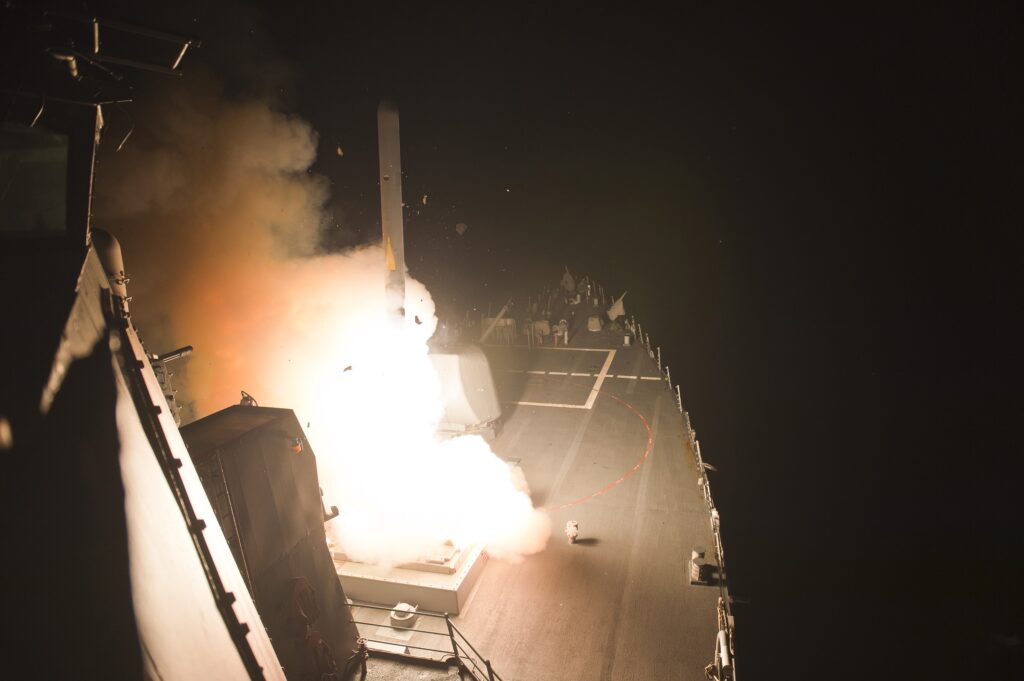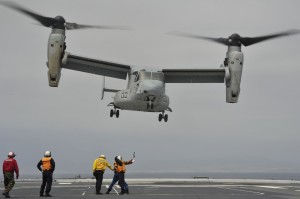Tablets & Tomahawks: Navy, Marines Scramble To Innovate
Posted on

Tomahawk cruise missile launch against Khorasan group in Syria
NATIONAL HARBOR, MD: Amidst unabated budget gloom, Navy and Marine leaders aren’t looking for salvation in big new programs. They’re “repurposing and reusing existing capabilities” to get the maximum out of existing hardware for minimum cost. It’s a vision of the future in which a junior Marine Corps officer might call for fire support from a ship-launched Tomahawk missile using a Samsung tablet.
Fiscal necessity is the mother of this inventiveness. The new meaning for R&R is “repurposing and reusing existing capabilities,” Adm. Jonathan Greenert, chief of Naval Operations, said at the Navy League’s annual Sea-Air-Space conference today. “In this fiscal environment we’re going to need to learn to live within the means provided [and] use the capabilities we have in new ways to confound the adversary.”
“We’re at historic low levels in ground modernization [particularly],” Marine Commandant Gen. Joseph Dunford said,” [and] I don’t think anyone believes the budget will stabilize in the next couple years.”
“One of the things that we’ve adjusted to over the last few years without spending a lot of money — although we definitely will spend more on command and control systems in particular — is the nature of distributed operations,” Dunford went on during his own panel, citing “remarkable” innovation in coordinating far-flung forces.
“When I was a rifle company commander, we defended on a 1500-meter frontage and attacked on 300-meter frontage,” Dunford said. By contrast, on a single day in February, a single Special Purpose Marine Air-Ground Task Force had one company securing the embassy in Baghdad, another evacuating the embassy in Yemen, and a third training allies in Jordan. Meanwhile the SPMAGTF headquarters was working with Iraqi ground forces, its V-22s were flying rescue teams in case strike planes went down over Iraq or Syria, and its jet fighters were flying out of Bahrain. All told, said Dunford, “that’s a task force of about 2,500 marines spread over six countries in a single day.”
That’s a tremendous stretch for traditional command and control systems. Just to know where you are, Marine Maj. Scott Cuomo told me, “you would need boxes upon boxes of maps.” What’s more a Marine battalion traditionally has a single staffer assigned to make maps, using a single laminating machine — which in distributed operations is probably going to be in a different country from the Marines who need the maps. That’s where the tablets come in.
In his previous job at the Marines’ Infantry Officer Course, Cuomo led experiments in using commercial Samsung tablets to transmit maps, orders, and text messages over jury-rigged military radios to and from Marines riding in V-22s.
In several years of “Talon Reach” wargames with the V-22, “one of the things we realized is that the Marines in the back just didn’t have the situational awareness that we wanted them to have,” said Marine Lt. Gen. Ronald Bailey. “If the information or intel changed while they were in route, we really didn’t have any way of that information to them right away.” Once the Marines improvised the use of commercial tablets connected to their military radios, he went on, “we were doing chat, we were exchanging from one [aircraft] to another change in plans, and we’re also working on how we’re going to link that in to the capability of the F-35.
At Sea-Air-Space, Cuomo was showing off an Android app called KILSWITCH. (Yes, it’s a highly contrived acronym). Able to run on a wide range of commercial phones and tablets — including a number of NSA-approved encrypted devices — KILSWITCH provides a Google Earth-like mapping function on which the user can overlay military graphics and planning diagrams, then share them over a network. You can also use KILSWITCH to call in fire support. In fact, it was originally designed for JTACs, the Joint Tactical Air Controllers who call in airstrikes, but it’s now spread to Marine Corps aviators and infantry.
“When we talk about cheap innovation, the government made the software,” Cuomo said using Navy engineers to write KILSWITCH rather than hiring costly outside contractors. At the same time, the government gets to surf the wave of commercial development in mobile devices, rather than invent the underlying technologies itself as in (for example) stealth). “Samsung spends $13.4 billion roughly on R&D a year, Google spends roughly $9 billion,” Cuomo said. “How do you leverage that” — with a relatively small investment of government money — “to enable the warfighter?”
 Ships and Missiles
Ships and Missiles
Modest upgrades to electronics and hardware can get new life out of existing weapons, too. The Tomahawk Land Attack Missile was designed to strike static ground targets, as it name implies, but the military recently tested modified TLAMs both in anti-ship strikes and in close support to Marine infantry in (simulated) combat.
“It exists, we bought it, what can do to that warhead to adjust it?” Rear Adm. Kevin Donegan said. That principle of getting more missions out of existing missiles doesn’t just apply to Tomahawk, Donegan told me after a panel at the conference: It holds for the Harpoon, historically an anti-ship weapon but capable of land attack; for the Standard Missile, designed for air defense; and even for torpedoes.
“Up here in the middle we have a picture of a missile leaving a tube,” said Greenert, showing a slide of a Navy warship firing its Vertical Launch System. “Is that a surface to air missile or is that a surface to surface missile?…. The enemy may not know. I think that’s pretty cool.
Conversely, Greenert cautioned, just as the Navy needs to get the most out of small investments, it may need to reign in big ones. After painful overruns on its next-generation aircraft carrier, the USS Gerald Ford, for example, the Navy is working hard to keep the cost of the next ship of the class, John F. Kennedy, under control — including by installing a less powerful radar. That may not be the only performance requirement that gets dialed down.
“I am ready to descope as the case may be,” Greenert said. “‘As the requirements generator, I meet frequently with Mr. [Sean] Stackley, our acquisition executive…. What does it take to bring this thing under the cost cap? We’ll do that because we have to do that.”
The high cost of warships has the Navy exploring new uses for non-combat ships. For example, it’s installing or upgrading helicopter landing pads strong enough to take the V-22, the Marine Corps’ favorite transport and now the Navy’s new shore-to-ship delivery aircraft. The Marines have also worked with allies to get the V-22 certified for landing on French and Spanish warships, Bailey said, further expanding the potential platforms.
Of course, the Marines would prefer to operate off US Navy amphibious warships, not off foreign or non-combat vessels. While ships like the new Afloat Forward Staging Base, derived from a civilian tanker, can fill in for amphibs in many peacetime missions, said Dunford, in even modestly dangerous scenarios, they will need a lot of careful handling and protection. But the Navy has 31 amphibious ships while theater commanders have missions enough for 50, a number the shipbuilding budget will never reach. Given that gap, said Dunford, “we can sit and admire the problem or we can take a look at the tools that we have available to us.”
Subscribe to our newsletter
Promotions, new products and sales. Directly to your inbox.
